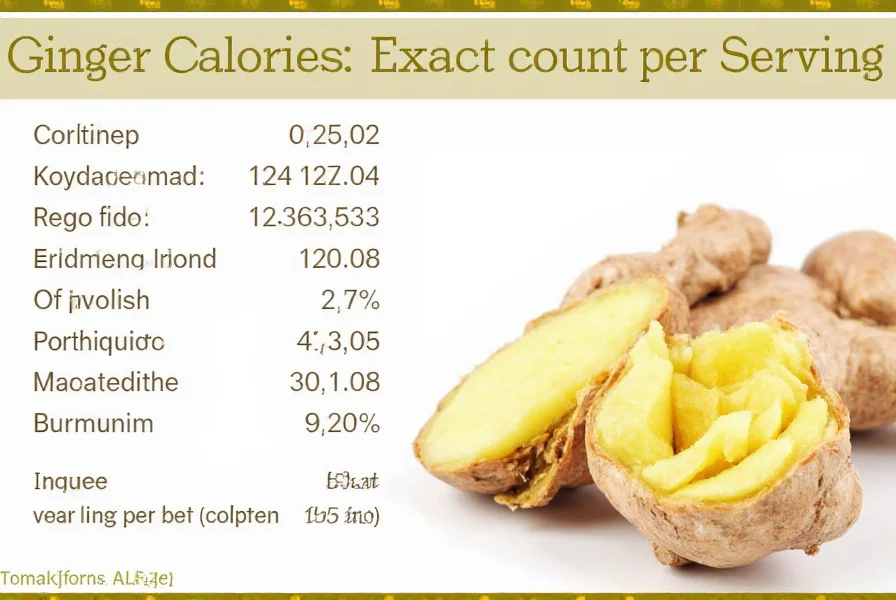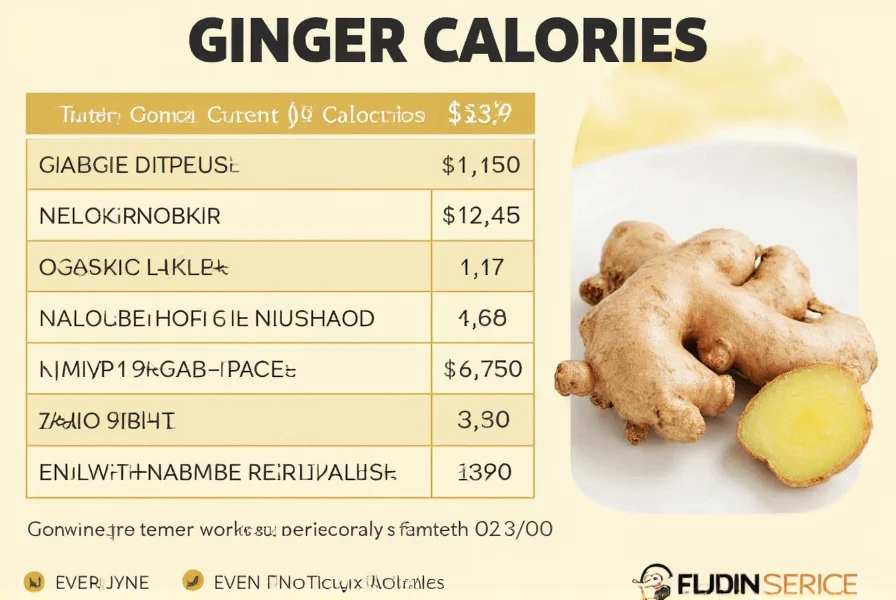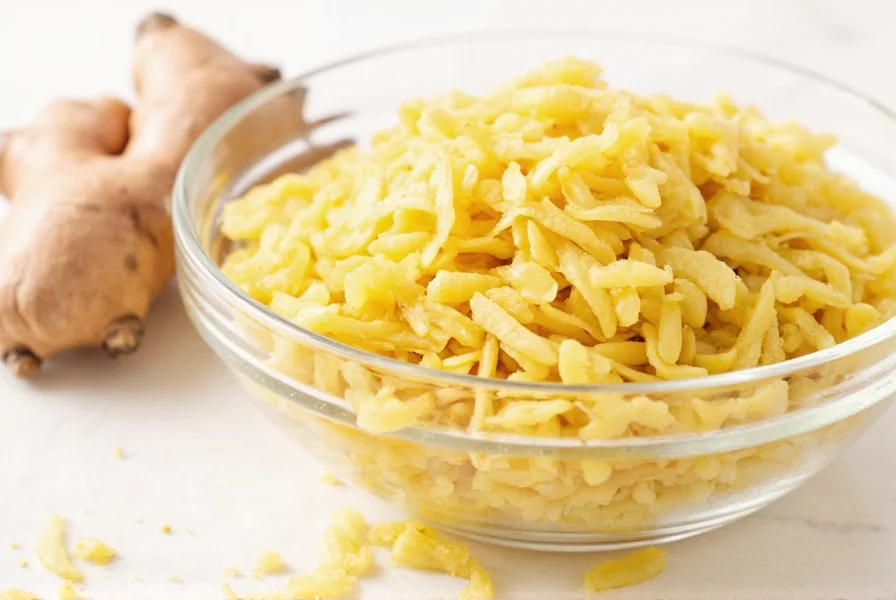Ginger isn't just a flavorful spice—it's a nutritional powerhouse with minimal caloric impact. Understanding the exact calorie content of ginger in various forms helps health-conscious individuals incorporate this versatile root into their diets strategically. Whether you're using fresh ginger root, powdered ginger, or enjoying ginger tea, knowing the precise nutritional information allows for accurate meal planning and dietary tracking.
Nutritional Profile of Ginger
Ginger's exceptionally low calorie count is just one aspect of its impressive nutritional profile. This aromatic root contains virtually no fat and minimal carbohydrates, making it suitable for various dietary approaches including keto, low-carb, and calorie-restricted eating plans.
| Ginger Form | Serving Size | Calories | Carbohydrates (g) | Protein (g) |
|---|---|---|---|---|
| Fresh ginger root | 1 tablespoon (6g) | 4-5 | 1 | 0.1 |
| Fresh ginger root | 1 ounce (28g) | 20 | 4.8 | 0.5 |
| Ground ginger | 1 teaspoon (2g) | 6 | 1.4 | 0.2 |
| Ginger tea (unsweetened) | 8 fl oz (240ml) | 2-3 | 0.5 | 0 |
| Candied ginger | 1 ounce (28g) | 90-100 | 24 | 0 |
Understanding Ginger in Different Forms
The calorie content of ginger varies significantly depending on its preparation method. Fresh ginger root maintains the lowest calorie density, while processed forms like candied ginger contain substantially more calories due to added sugars.
When considering calories in fresh ginger root for cooking, remember that the actual amount consumed in most recipes is relatively small. A typical stir-fry might use 1-2 tablespoons of freshly grated ginger, contributing only 4-10 calories to the entire dish. This makes ginger an excellent flavor enhancer without substantially impacting the meal's total calorie count.
For those wondering how many calories in ginger tea, unsweetened versions contain minimal calories—typically just 2-3 calories per 8-ounce serving. The calorie count increases significantly when honey, sugar, or other sweeteners are added, which is important information for those tracking their ginger for weight loss calories.
Ginger's Role in Weight Management
While ginger itself contains minimal calories, research suggests it may offer benefits for weight management through other mechanisms. Some studies indicate that ginger may help increase thermogenesis (calorie burning) and reduce feelings of hunger.
The compound gingerol, responsible for ginger's distinctive flavor and aroma, appears to influence metabolic processes. When incorporated as part of a balanced diet, ginger can enhance flavor without adding significant calories—a valuable attribute for those following calorie-conscious eating patterns.
Understanding the precise raw ginger calorie count helps dieters make informed choices. For example, substituting fresh ginger for higher-calorie flavor enhancers like sauces or dressings can reduce overall meal calories while maintaining satisfying flavor profiles.
Practical Applications in Daily Diet
Incorporating ginger into your diet requires minimal effort but delivers maximum flavor with minimal caloric cost. Here are practical ways to use ginger while maintaining awareness of ginger nutritional facts per ounce:
- Add freshly grated ginger to morning smoothies (1-2 teaspoons adds only 2-4 calories)
- Use ginger in salad dressings instead of higher-calorie alternatives
- Infuse water with fresh ginger slices for a calorie-free flavorful beverage
- Include ginger in marinades for lean proteins to enhance flavor without added calories
- Choose fresh ginger over candied varieties when monitoring ginger spice calorie information
For cooking enthusiasts tracking nutritional content, knowing the exact calories in ginger root per tablespoon helps maintain accurate food logs. This precision becomes particularly valuable for those following strict dietary protocols or managing specific health conditions.

Common Misconceptions About Ginger and Calories
Several misconceptions exist about ginger's caloric impact. Some believe that because ginger has a strong flavor, it must contain significant calories—but this isn't the case. The intense flavor comes from bioactive compounds, not caloric density.
Another common misunderstanding involves does ginger have calories when boiled. The calorie content remains essentially the same whether ginger is raw, cooked, or boiled—the water-soluble compounds may leach into cooking liquid, but the total caloric value doesn't increase.
For those using ginger as part of weight management strategies, it's crucial to distinguish between fresh ginger's minimal calorie contribution and processed ginger products that often contain added sugars and substantially more calories.

Conclusion
Ginger represents an exceptional example of a flavorful ingredient with minimal caloric impact. With just 4-5 calories per tablespoon of fresh root, it offers culinary versatility without compromising dietary goals. Understanding the precise ginger calories in various forms empowers informed dietary choices, whether you're managing weight, following specific nutritional protocols, or simply tracking your daily intake.
By incorporating fresh ginger into your cooking and beverages while being mindful of preparation methods, you can enjoy its distinctive flavor and potential health benefits without concern for significant caloric contribution. This knowledge of ginger nutritional information helps transform how we approach flavoring our foods in a health-conscious manner.
How many calories are in one inch of ginger root?
One inch of fresh ginger root (approximately 15 grams) contains about 10 calories. The exact count varies slightly based on the thickness and moisture content of the ginger, but this provides a reliable estimate for dietary tracking purposes.
Does ginger tea contain significant calories?
Unsweetened ginger tea contains minimal calories—typically just 2-3 calories per 8-ounce serving. The calorie count increases substantially when sweeteners like honey or sugar are added, so those monitoring their calorie intake should consume ginger tea plain or with non-caloric sweeteners.
Is fresh ginger lower in calories than ground ginger?
Yes, fresh ginger contains fewer calories by volume compared to ground ginger. One tablespoon (6g) of fresh ginger has 4-5 calories, while one teaspoon (2g) of ground ginger contains about 6 calories. This difference occurs because ground ginger is more densely packed, so a smaller volume contains more ginger material.
Can ginger help with weight loss despite containing calories?
While ginger itself contains minimal calories (4-5 per tablespoon), some research suggests it may support weight management through other mechanisms. Ginger may help increase thermogenesis (calorie burning), reduce hunger, and improve digestion. When used to enhance flavor instead of higher-calorie ingredients, it can help reduce overall meal calories while maintaining satisfaction.
How does candied ginger's calorie content compare to fresh ginger?
Candied ginger contains significantly more calories than fresh ginger due to added sugars. While one ounce (28g) of fresh ginger has about 20 calories, the same amount of candied ginger contains 90-100 calories. Those monitoring their calorie intake should be aware of this substantial difference when choosing between ginger forms.











 浙公网安备
33010002000092号
浙公网安备
33010002000092号 浙B2-20120091-4
浙B2-20120091-4